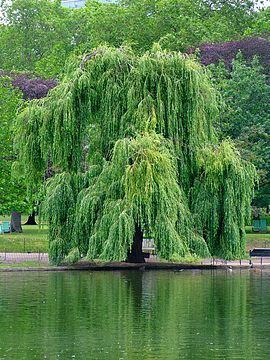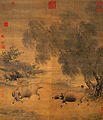
Willow
About this schools Wikipedia selection
This content from Wikipedia has been selected by SOS Children for suitability in schools around the world. Sponsoring children helps children in the developing world to learn too.
| Willow | |
|---|---|
 |
|
| Salix × sepulcralis - weeping willow | |
| Scientific classification | |
| Kingdom: | Plantae |
| Division: | Magnoliophyta |
| Class: | Magnoliopsida |
| Order: | Malpighiales |
| Family: | Salicaceae |
| Genus: | Salix L. |
| Species | |
|
About 350, including: |
|
Willows, sallows and osiers form the genus Salix, around 400 species of deciduous trees and shrubs, found primarily on moist soils in cold and temperate regions of the Northern Hemisphere. Most species are known as willow, but some narrow-leaved shrub species are called osier, and some broader-leaved species are called sallow (the latter name is derived from the Latin word salix, willow). Some willows (particularly arctic and alpine species), are low-growing or creeping shrubs; for example the dwarf willow (Salix herbacea) rarely exceeds 6 cm in height, though spreading widely across the ground.
Willows are very cross-fertile and numerous hybrids occur, both naturally and in cultivation. A well known example is the weeping willow (Salix × sepulcralis), very widely planted as an ornamental tree, which is a hybrid of a Chinese species and a European species – Peking willow and white willow.
Description
The willows all have abundant watery sap, furrowed scaly bark which is heavily charged with salicylic acid, soft, usually pliant, tough wood, slender branches and large, fibrous, often stoloniferous roots. The roots are remarkable for their toughness, size, and tenacity of life, and roots readily grow from aerial parts of the plant.
The leaves are typically elongated but may also be round to oval, frequently with a serrated margin. All the buds are lateral; no absolutely terminal bud is ever formed. The buds are covered by a single scale, enclosing at its base two minute opposite buds, alternately arranged, with two, small, scale-like, fugacious, opposite leaves. The leaves are alternate, except the first pair which fall when about an inch long. They are simple, feather-veined, and typically linear-lanceolate. Usually they are serrate, rounded at base, acute or acuminate. The leaf petioles are short, the stipules often very conspicuous, looking like tiny round leaves and sometimes remaining for half the summer. On some species, however, they are small, inconspicuous, and fugacious (soon falling). In colour the leaves show a great variety of greens, ranging from yellowish to blueish.
Flowers
Willows are dioecious with male and female flowers appearing as catkins on different plants; the catkins are produced early in the spring, often before the leaves, or as the new leaves open.
The staminate (male) flowers are without either calyx or corolla; they consist simply of stamens, varying in number from two to ten, accompanied by a nectariferous gland and inserted on the base of a scale which is itself borne on the rachis of a drooping raceme called a catkin, or ament. This scale is oval and entire and very hairy. The anthers are rose colored in the bud but orange or purple after the flower opens, they are two-celled and the cells open longitudinally. The filaments are threadlike, usually pale yellow, and often hairy.
The pistillate (female) flowers are also without calyx or corolla; and consist of a single ovary accompanied by a small flat nectar gland and inserted on the base of a scale which is likewise borne on the rachis of a catkin. The ovary is one-celled, the style two-lobed, and the ovules numerous.
Fruit
The fruit is a small capsule containing numerous tiny (0.1 mm) seeds embedded in white down, which assists wind dispersal of the seeds. The fruit is a one-celled, two-valved, cylindrical, beaked capsule, containing many minute seeds which are furnished with long, silky, white hairs. The catkins appear before or with the leaves.
Cultivation
Almost all willows take root very readily from cuttings or where broken branches lie on the ground. There are a few exceptions, including the goat willow and peachleaf willow. One famous example of such growth from cuttings involves the poet Alexander Pope, who begged a twig from a parcel tied with twigs sent from Spain to Lady Suffolk. This twig was planted and thrived, and legend has it that all of England's weeping willows are descended from this first one.
Willows are often planted on the borders of streams so that their interlacing roots may protect the bank against the action of the water. Frequently the roots are much larger than the stem which grows from them.
Ecological issues
Willows are used as food plants by the larvae of some Lepidoptera species - see list of Lepidoptera that feed on willows.
A number of willow species were widely planted in Australia, notably as erosion control measures along watercourses. They are now regarded as an invasive weed and many catchment management authorities are removing them to be replaced with native trees.
Uses
Medicinal uses
The leaves and bark of the willow tree have been mentioned in ancient texts from Assyria, Sumer and Egypt as a remedy for aches and fever, and the Ancient Greek physician Hippocrates wrote about its medicinal properties in the 5th century BC. Native Americans across the American continent relied on it as a staple of their medical treatments. This is because they contain salicylic acid, the precursor to aspirin.
In 1763 its medicinal properties were observed by the Reverend Edward Stone in England. He notified the Royal Society who published his findings. The active extract of the bark, called salicin, was isolated to its crystalline form in 1828 by Henri Leroux, a French pharmacist, and Raffaele Piria, an Italian chemist, who then succeeded in separating out the acid in its pure state. Salicin is acidic when in a saturated solution in water (pH = 2.4), and is called salicylic acid for that reason.
In 1897 Felix Hoffmann created a synthetically altered version of salicin (in his case derived from the Spiraea plant), which caused less digestive upset than pure salicylic acid. The new drug, formally Acetylsalicylic acid, was named aspirin by Hoffmann's employer Bayer AG. This gave rise to the hugely important class of drugs known as non-steroidal anti-inflammatory drugs (NSAIDs).
Other uses
- As a plant
- Agroforestry, biofiltration, constructed wetlands, ecological wastewater treatment systems, hedges, land reclamation, landscaping, phytoremediation, streambank stabilisation ( bioengineering), slope stabilisation, soil erosion control, shelterbelt & windbreak, soil building, soil reclamation, tree bog compost toilet, wildlife habitat
- Agriculture
- Willow bark contains auxins: plant growth hormones, especially those used for rooting new cuttings. The bark can even be used to make a simple extract that will promote cutting growth.
- Energy source
- Charcoal, energy forestry such as the Willow Biomass Project
- Wood
- Boxes, brooms, cricket bats (grown from certain strains of white willow), cradle boards, chairs and other furniture, dolls, flutes, poles, sweat lodges, toys, turnery, tool handles, veneer, wands, whistles
- Wicker (often from osiers)
- Basket weaving, fish traps, wattle fences, wattle and daub
- Other wood-derived products
- Fibre plants, paper, rope and string, tannin
- Art
- Willow charcoal (for drawing), living sculpture
- Religion
- As one of the " Four Species" used in a ceremony on the Jewish holiday of Sukkot.
Willow in human culture
The willow is a famous subject in many East Asian nations' cultures particularily painting (pen and ink) in china and japan.
Gisaeng Hongrang, who lived in the middle of the Joseon period, wrote:
like willow I will be the willow on your bedside.
Hongrang wrote this poem by the willow in the rain in the evening which she gave to her parting lover
In English folklore, a willow tree is believed to be quite sinister, capable of uprooting itself and stalking travellers.
Willow trees are quite prevalent in folklore and myths.
In literature
Hans Christian Andersen wrote a story called Under The Willow Tree (1853) in which children ask questions of a tree they call 'willow-father', paired with another entity called 'elder-mother'.
Green Willow is a Japanese ghost story in which a young samurai falls in love with a woman called Green Willow who has a close spiritual connection with a willow tree. The Willow Wife is another, not dissimilar tale. Wisdom of the Willow Tree is an Osage Nation story in which a young man seeks answers from a Willow tree, addressing the tree in conversation as 'Grandfather'.
Pictures
-
Weeping willow (Salix × sepulcralis) in Auckland, New Zealand
-
Dwarf willow (Salix herbacea), Sweden
-
PICT3750small.jpg
Willow leaves (Salix × sepulcralis)
-
Willow tree in a painting by Chinese artist Li Di, 12th century, Song Dynasty.





